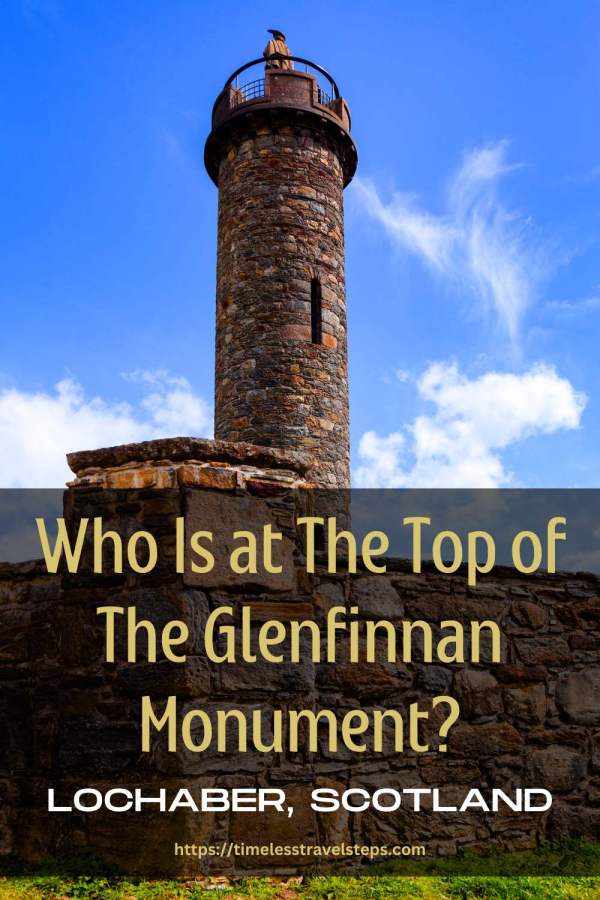Top of Glenfinnan Monument: A Story of Bonnie Prince Charlie and The Highlander
13 min readIn this post, my aim is to provide an engaging overview of the rich history of the Glenfinnan Monument. This will enhance your understanding and appreciation for this landmark when you visit Loch Shiel. The monument is an unmissable attraction in Glenfinnan, offering a unique window into Scotland's storied past.
The post Top of Glenfinnan Monument: A Story of Bonnie Prince Charlie and The Highlander appeared first on Timeless Travel Steps.
At the heart of the Scottish Highlands, overlooking the serene waters of Loch Shiel, stands the Glenfinnan Monument, crowned by a striking statue of a Highlander. This imposing structure is steeped in the history of Bonnie Prince Charlie and the 1745 Jacobite Rising, serving as a vivid reminder of Scotland‘s turbulent past.
The monument, a symbol of national heritage, pays homage to the brave Jacobite soldiers who rallied behind Prince Charles Edward Stuart, known popularly as Bonnie Prince Charlie.
In this post, my aim is to provide an engaging overview of the rich history of the Glenfinnan Monument. This will enhance your understanding and appreciation for this landmark when you visit Loch Shiel. The monument is an unmissable attraction in Glenfinnan, offering a unique window into Scotland’s storied past.
In particular, I shall focus on the Highlander at its top, and to unravel its deep connections with Bonnie Prince Charlie. I’ll share information from my research and my visit to this serene haven recently. It’s not just the physical attributes of the monument and its iconic statue but also the historical, cultural, and emotional significance it holds in the collective memory of Scotland.
I welcome you to read along…
Timeless Travel Steps is supported by our readers. If you purchase through an affiliate link on my site, at no cost to you, I may earn a commission from qualifying purchases. Please read our Disclosure.
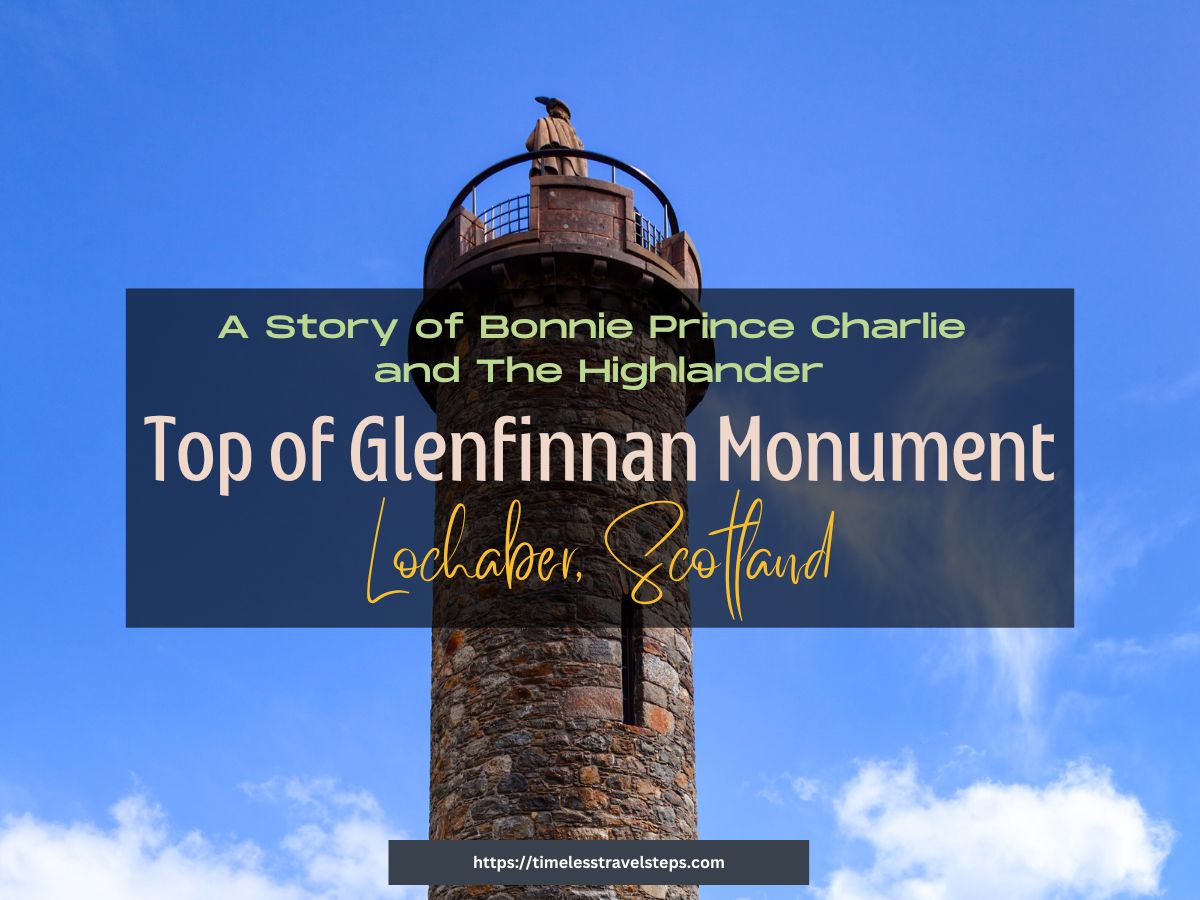
Historical Background of the Glenfinnan Monument
The Glenfinnan Monument, masterfully designed by renowned Scottish architect James Gillespie Graham, was erected in 1815 as a lasting tribute to the Jacobite clansmen. Its strategic location at the head of Loch Shiel was chosen with historical precision; it marks the exact site where Bonnie Prince Charlie, full name Charles Edward Stuart, raised his standard on 19th August 1745, igniting the Jacobite Rising. It was here, where 1200 Highlanders gathered in support of their prince.
This rebellion was a significant yet ultimately unsuccessful attempt to reclaim the British throne for the Stuart dynasty. The choice of location was not just symbolic but also deeply evocative of the Jacobite spirit. The surrounding landscape of the Highlands, with the nearby Glenfinnan Viaduct adds to the monument’s dramatic setting.
Notably, the monument is situated close to Fort William, a key site in Scottish history, further anchoring its relevance. The monument’s inauguration, attended by Alexander MacDonald of Glenaladale, who was a key supporter of Prince Charlie, was a solemn acknowledgment of the enduring impact of the Jacobite Risings on Scottish history and identity.
Today, the site also includes a visitor centre, managed by the National Trust for Scotland, providing an educational and immersive experience for those keen to delve deeper into this pivotal chapter of Scottish history.
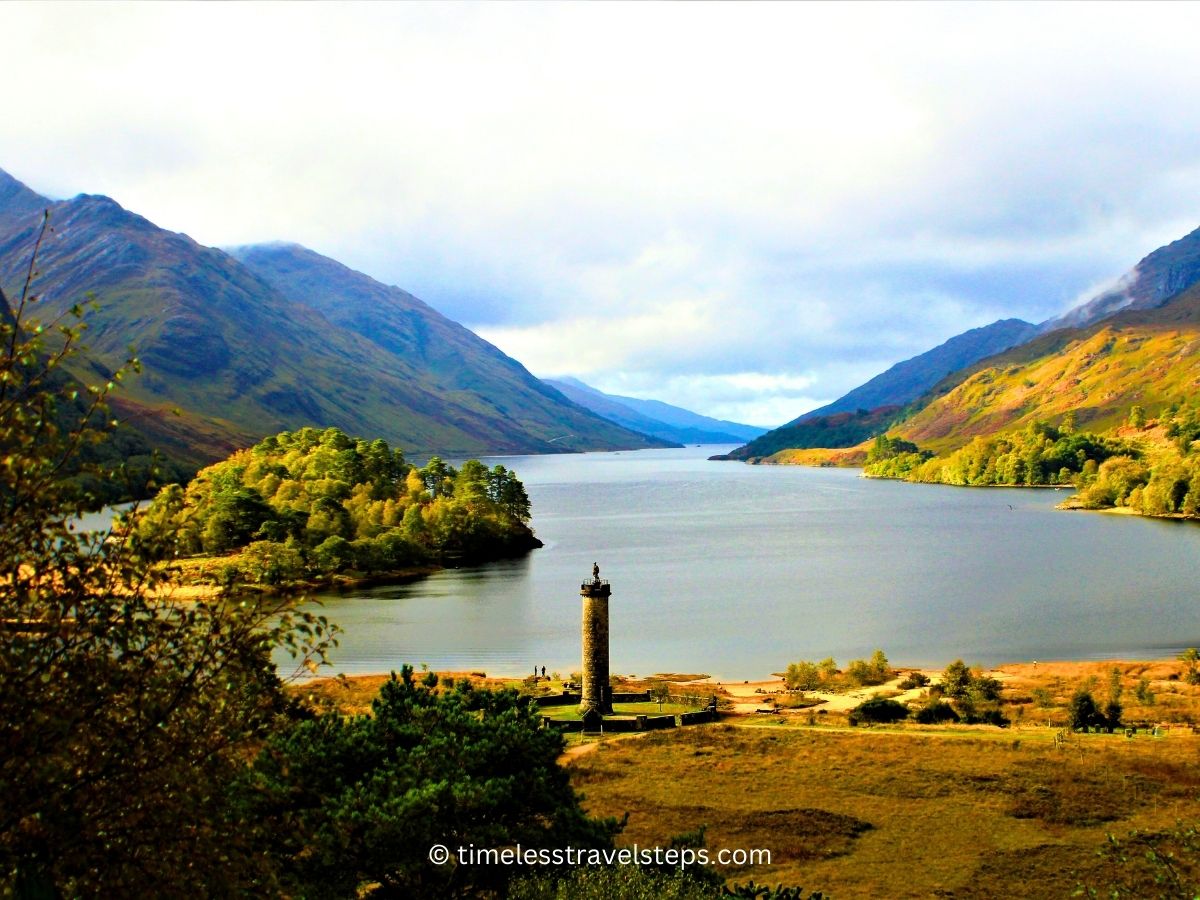
The Significance of the Highlander Statue on Top of the Monument
The Highlander statue, standing proudly at the top of Glenfinnan Monument, is not only a striking visual element but also a profound symbol of Scottish history and valor. This solitary figure, simply known as the “Unknown Highlander,” clad in traditional Highland garb, is a poignant representation of the Jacobite clansmen who fought and gave their lives under Bonnie Prince Charlie during the 1745 Jacobite Rising.
Its placement, overlooking the serene Loch Shiel, is symbolic of the highlanders’ vigilance and their unyielding spirit in the face of adversity. Dedicated to the clansmen of the Jacobite cause, the statue is crafted with meticulous attention to detail, embodying the essence of the Jacobite Highlander — the kilt, the bonnet, and the demeanor all resonate with the cultural identity of the Highland warriors. These details are not just artistic choices; they are deliberate nods to the traditional dress and fighting spirit of the clansmen who rallied for Prince Charles Edward Stuart’s cause. Importantly, the statue serves as a memorial to the courage and sacrifices of these men.
The Jacobite Rising, though romanticized in history and popular culture, was a period marked by fierce battles and significant loss. The Highlander at the top of Glenfinnan Monument stands as a silent guardian of their legacy, ensuring that the stories of these brave souls continue to inspire and resonate with visitors from around the world. The monument, therefore, transcends its role as a mere historical marker, becoming a place of reflection, remembrance, and a testament to the enduring spirit of the Scottish people.
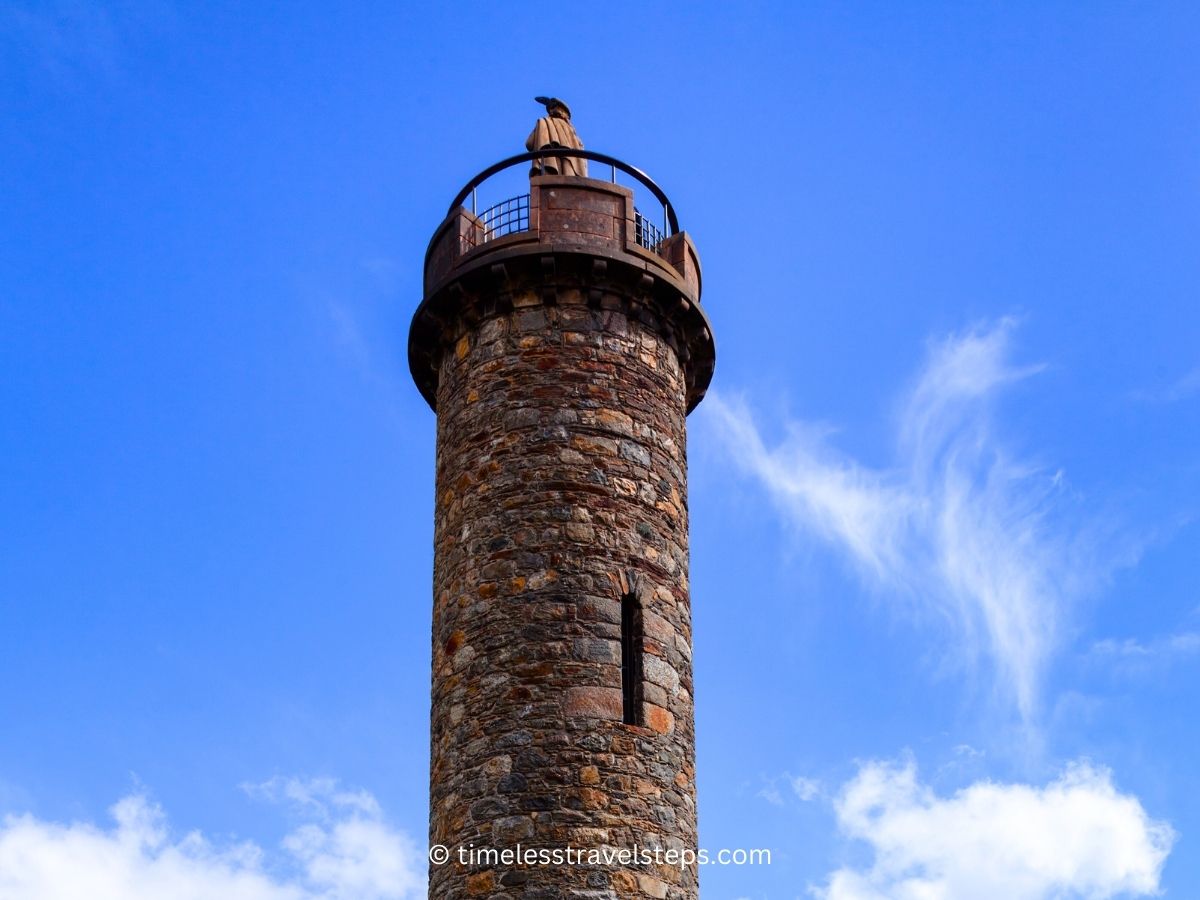
Bonnie Prince Charlie and the Jacobite Rising
Bonnie Prince Charlie, born Charles Edward Stuart in 1720 in Rome , remains a vivid and legendary figure in Scottish history. As the heir to the exiled Stuart dynasty, his life was marked by a burning ambition to reclaim his family’s lost throne.
His arrival in Scotland in 1745 set off the Jacobite Rising, a valiant but ultimately doomed effort to restore his father, James Francis Edward Stuart, to the thrones of England and Scotland. Charlie’s youthful energy, romantic portrayal as a dashing prince, and his magnetic personality inspired fierce loyalty and devotion, rallying numerous Highland clans to his cause.
Despite early triumphs like the victory at the Battle of Prestonpans, the Rising, often romanticized in Scottish lore, was fraught with challenges. The devastating defeat at the Battle of Culloden in 1746 not only crushed the Jacobite cause but also led to harsh repercussions for the Scottish Highlands.
This period, characterized by both bravery and tragedy, deeply impacted Scotland’s narrative, with Bonnie Prince Charlie emerging as a symbol of resistance and unfulfilled dreams. The cultural and historical impact of Bonnie Prince Charlie and the Jacobite Rising has echoed through Scottish literature, music, and folklore, capturing the imagination of generations.
Works like “The Skye Boat Song” and Sir Walter Scott’s “Waverley” have immortalized this saga, ensuring its timeless appeal.
The Glenfinnan Monument, particularly the Highlander at its top, stands as a poignant tribute to this chapter in Scotland’s history. It symbolizes the enduring spirit of the Jacobite soldiers, and its presence continues to influence Scottish identity and nationalism. The monument, looking over Loch Shiel, marks where Prince Charlie raised his standard, serving as a reminder of the heroic yet turbulent fight for the Stuart cause.
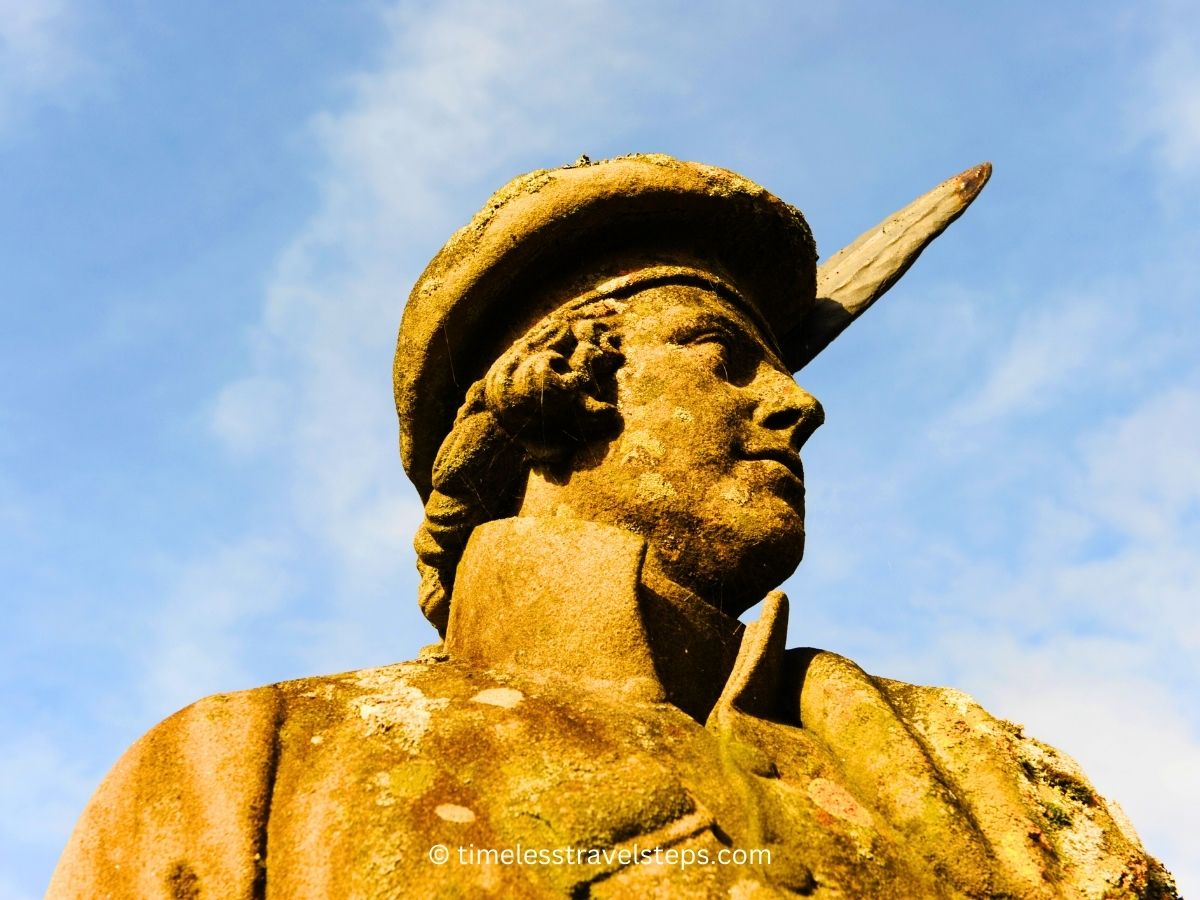
The Monument’s Role in Scottish Cultural Memory
The Glenfinnan Monument, crowned by the iconic Highlander statue at its top, has become a profound symbol of Scottish identity and historical memory. Its majestic presence near the Glenfinnan Viaduct, set against the stunning backdrop of the Scottish Highlands, adds a mystique that attracts a global audience, including Harry Potter fans drawn to the nearby viaduct featured in the films. Loch Shiel itself was used as the “Black Lake of Hogwarts” in the Potter series.
This monument transcends its role as a mere historical marker. It is a vibrant hub of cultural memory, especially during the annual commemorations around August 19th. These events, marking the anniversary of Bonnie Prince Charlie’s standard-raising in 1745, transform the monument into a living tableau of Scottish heritage with music, storytelling, and ceremonies.
Interaction with the monument is a journey through history. The adjacent visitor centre, curated by the National Trust for Scotland, offers immersive experiences like guided tours and exhibitions. These elements, along with informative plaques and signs, provide a rich narrative of the Jacobite Rising and the monument’s role in commemorating this pivotal chapter in Scottish history.
In modern Scotland, the Glenfinnan Monument, especially the Highlander at its top, resonates beyond its historical significance. It stands as a powerful testament to Scotland’s enduring spirit and its ongoing narrative of resilience, sovereignty, and identity. In a time of evolving political and cultural landscapes, the monument remains a poignant reminder of Scotland’s past struggles and a symbol of its aspirations, inspiring a sense of national pride and unity.
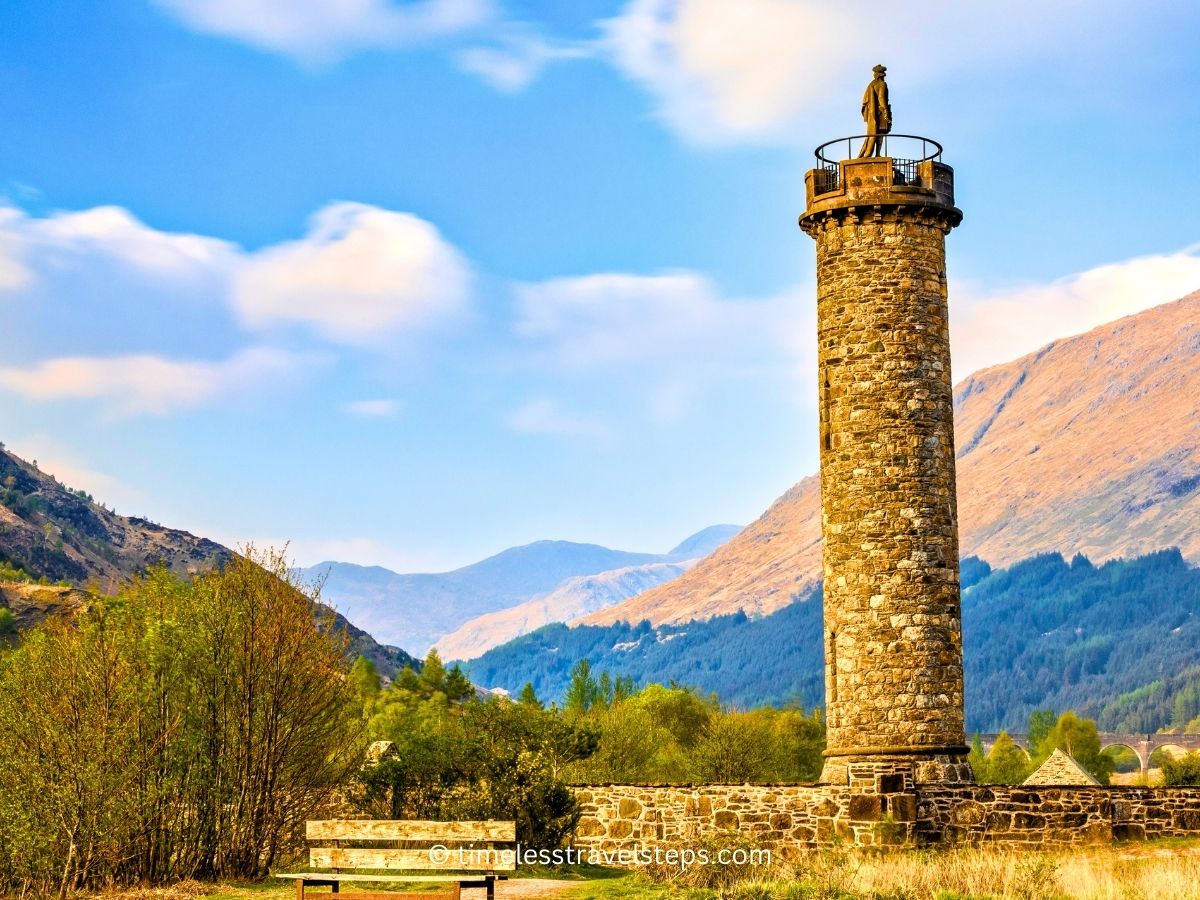
Glenfinnan Monument and Visitor Experience
Glenfinnan Monument, constructed of stone in a style that echoes traditional Scottish designs, is a sturdy structure that has braved the elements for over two centuries. Built in 1815, and towering at approximately 18 meters (around 60 feet) tall, the monument is a prominent feature, visible from various points around Loch Shiel, drawing the eye and the imagination.
Contrary to what one might expect, it is possible for adventurous visitors to ascend to the top of the monument. This unique experience requires a ticket, available from the nearby visitor centre managed by the National Trust for Scotland.
The climb is somewhat challenging, as visitors must navigate through a 40cm square hatch, and 62 steps, using the handrail on either side. With a limit of six people at the top at any time, this experience offers an intimate and breathtaking view of the surrounding landscape, though caution is advised, especially when descending.
The visitor centre nearby provides a wealth of information. Here, exhibitions and detailed narratives about the monument’s history, particularly its connection to the Jacobite Rising, await the curious traveller. This centre not only enhances the experience of visiting the monument but also offers a deeper understanding of the pivotal events it commemorates.
In sum, a visit to the Glenfinnan Monument is not just a journey through Scotland’s past but an opportunity to engage with history in a tangible and memorable way. Whether viewing the monument from its base, learning about its significance at the visitor centre, or ascending to its summit, you are sure to leave with a profound appreciation of this iconic Scottish landmark.
The National Trust for Scotland and Conservation of the Glenfinnan Monument
As you approach the monument, set against the dramatic Highlands and near the iconic Glenfinnan Viaduct, you are greeted by breathtaking views of Loch Shiel, a vista that Bonnie Prince Charlie himself would have admired.
Conservation efforts at the Glenfinnan Monument are ongoing, ensuring its preservation as a vital link to Scotland’s past. The National Trust for Scotland, responsible for the monument, undertakes regular maintenance and restoration work, preserving its structural integrity and historical accuracy. These efforts ensure that visitors can continue to connect with Scotland’s history in an authentic and meaningful way, safeguarding this iconic site for future generations to experience and learn from.
Stay Connected with Timeless Travel Steps for the latest in our Travel News
How to Reach Glenfinnan Monument
Visiting the Glenfinnan Monument, requires a bit of planning, especially when it comes to transportation and parking. Here are some practical tips to help you plan your visit:
Reaching Glenfinnan Monument by Road: The Glenfinnan Monument is located in the West Highlands of Scotland, about 27 kilometers (17 miles) west of Fort William. If you’re driving, use the following postcode PH37 4LT, to reach the nearest car park to the monument. The most direct route is along the A830 road, often referred to as the ‘Road to the Isles.’ This road connects Fort William to Mallaig and passes directly through Glenfinnan. The drive from Fort William to Glenfinnan is scenic and enjoyable, taking approximately 30 minutes. Keep an eye out for stunning views of the Scottish countryside.
Parking at Glenfinnan: Once you arrive in Glenfinnan, PH37 4LT, you will find a dedicated visitor car park close to the monument. This car park is managed by the National Trust for Scotland. During peak tourist season, the car park can fill up quickly, so it’s advisable to arrive early in the day, especially if you’re visiting during summer or on weekends. There is a parking fee, which helps in the maintenance and conservation of the site. Members of the National Trust for Scotland can park for free.
If you are looking to rent a car, you could hire one here.
From the car park, it’s a short, easy walk to the monument itself. The path is well-marked and offers beautiful views of Loch Shiel and the surrounding area.
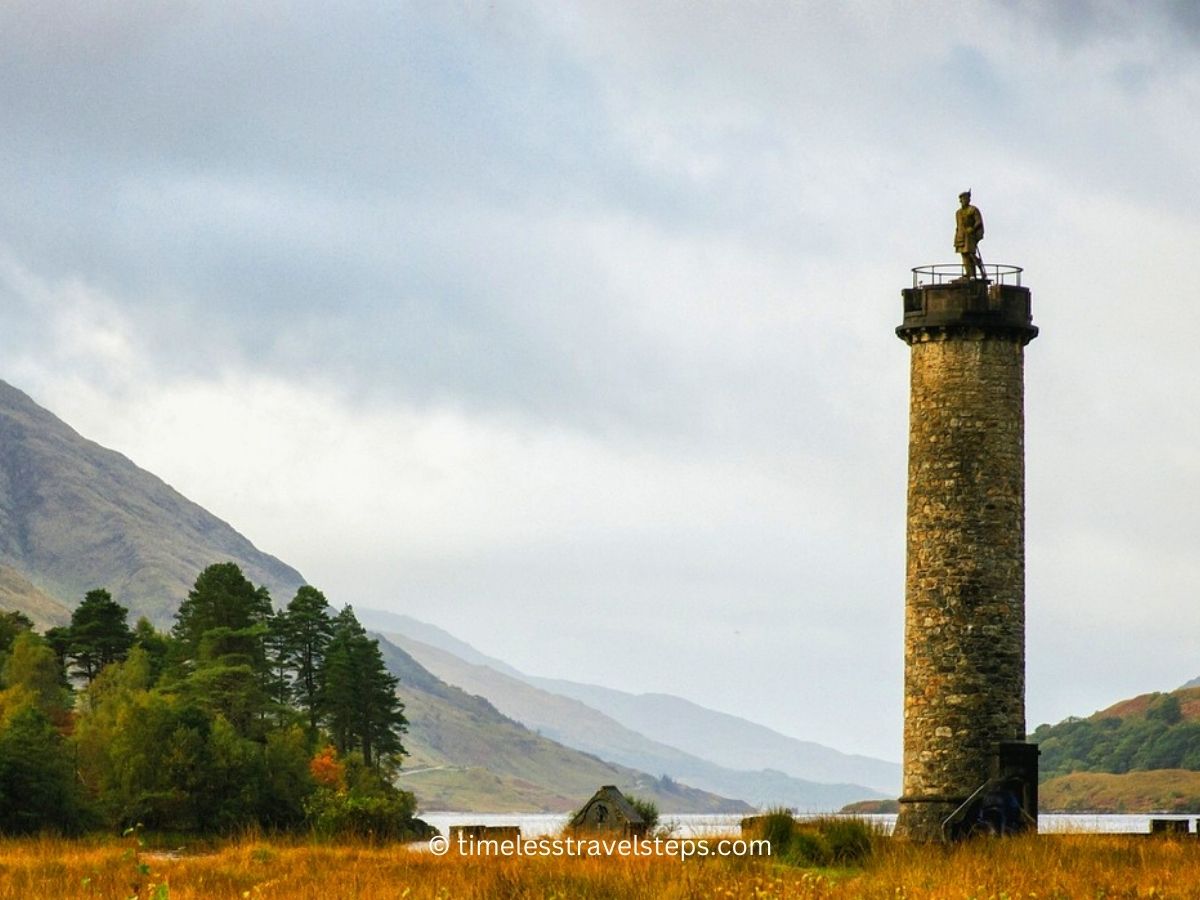
Best Time to Visit Glenfinnan Monument Optimal Visiting Seasons:
The best time to visit the Glenfinnan Monument is during the late spring to early autumn months, from May to September. During this period, the weather is generally milder and more conducive to outdoor activities.
Summer (June to August) is particularly popular, offering longer daylight hours and warmer temperatures, ideal for exploring the area and enjoying the stunning landscapes. However, be prepared for it to be busier during these months, and the onset of the midge season.
Considerations for Timing: If you prefer a quieter experience, consider visiting in the late spring (May) or early autumn (September). These months offer a balance of pleasant weather and fewer tourists. Keep in mind that some facilities, like the visitor centre or guided tours, may have reduced hours or availability outside of the peak tourist season.
Attractions and Activities Nearby to Glenfinnan Monument
Glenfinnan Viaduct: Just a short distance from the monument is the famous Glenfinnan Viaduct, known worldwide for its appearance in the Harry Potter films. It’s a must-see for fans of the series and architecture enthusiasts.
Loch Shiel Cruises: Enjoy a cruise on Loch Shiel, where you can experience the area’s natural beauty from the water. These cruises often offer insights into the local wildlife and history.
Glenfinnan Station Museum: Visit the Glenfinnan Station Museum to learn about the history of the West Highland Railway. It’s a fascinating stop for train enthusiasts and history buffs.
Hiking Trails: The area around Glenfinnan offers numerous hiking trails. For a moderate hike with rewarding views, try the Glenfinnan Viaduct Trail.
Glenfinnan Church: Don’t miss the historic Glenfinnan Church, the Church of St Mary and St Finnan, also known as the Church of Our Lady and St Finnan. This church presents a unique architectural marvel situated in a peaceful and picturesque spot, perfect for a quiet moment of reflection.
These nearby attractions provide a rich and varied experience, complementing your visit to the Glenfinnan Monument and ensuring a memorable trip to the Scottish Highlands.
READ: Things to Do in Loch Shiel, An Idyllic Paradise for Slow Travellers
FAQs
The loch at Glenfinnan is known as Loch Shiel. It’s a significant and picturesque body of water in the Scottish Highlands, stretching over 28 kilometers in length. Loch Shiel is renowned for its natural beauty and historical importance, particularly as the backdrop for the Glenfinnan Monument. Its historical connection, especially to the Jacobite Rising, adds a layer of cultural depth to its appeal.
The Glenfinnan Monument was built by the Scottish architect James Gillespie Graham. It was erected in 1815 to commemorate the Jacobite Rising of 1745. Graham’s design reflects the traditional architectural styles of Scotland, and the monument has since become an iconic symbol of Scottish history and heritage, standing tall at the head of Loch Shiel.
The statue at the top of the Glenfinnan Monument is that of an anonymous Highlander, representing the Jacobite soldiers who participated in the 1745 uprising. This figure, clad in traditional Highland garb, is a symbolic tribute to the bravery and loyalty of the Jacobite clansmen who rallied behind Bonnie Prince Charlie in his attempt to restore the Stuart dynasty to the British throne. The statue’s presence atop the monument is both a poignant reminder of Scotland’s turbulent history and a symbol of national pride, encapsulating the spirit of the Highland warriors.
The name “Glenfinnan” is derived from the Gaelic language, which is deeply rooted in Scottish history and culture. In Gaelic, “glen” means a valley, and it’s a common prefix in Scottish place names, denoting a geographical feature. The latter part of the name, “Finnan,” is believed to be associated with Saint Finnan, a 6th-century Irish saint who was venerated in this part of Scotland. Thus, “Glenfinnan” essentially translates to “Finnan’s Valley” or “the valley of Saint Finnan.” This name reflects the area’s rich history and its connection to early Christian heritage in Scotland.
The parking fee at the Glenfinnan Monument is £3.50. This fee is applicable for the car park managed by the National Trust for Scotland (free for members), which is located conveniently close to the visitor centre and the monument itself. This parking area provides easy access to both the monument and the visitor centre, making it a practical choice for those coming to explore the area and learn about its rich history.
in essence…
The Glenfinnan Monument, with the Highlander at its top, stands not just as a stone structure but as a living symbol of Scotland’s tumultuous past and enduring spirit. It continues to inspire and educate, drawing visitors into the heart of Scottish history and heritage. As a testament to the bravery of the Jacobite soldiers and the resilience of the Scottish people, the monument transcends time, connecting the past with the present and reminding us of the ongoing narrative of Scotland’s identity and legacy.
I trust this detailed overview of the Glenfinnan Monument, particularly focusing on the symbolic Highlander at its top, has enriched your understanding of this iconic site. It’s my hope that this insight not only adds value to your visit but also inspires a deeper curiosity about the Highland’s storied past. The tales of bravery, struggle, and resilience that echo through the Glenfinnan Monument are just a glimpse into the rich tapestry of Scottish history, one that is worth exploring.
Happy and Safe Travels Always, Wherever Travel Takes You, xx
Before you go, take a look at some of my other helpful articles, for ideas to explore more of Scotland.
Explore more of Scotland
Things to Do in Loch Shiel, An Idyllic Paradise for Slow Travellers
Top of Glenfinnan Monument: A Story of Rebellion, Bonnie Prince Charlie + The Highlander
How to Navigate the Duncansby Stacks Walk Without a Tour.
Is Corrieshalloch Gorge Worth Visiting on a Scottish Road Trip?
Keiss Castle Coastal Walk: Scotland’s NC500 Hidden Gem
Keiss Village: Castles, Coastline, and Caithness Charm
Discover Why Ullapool Is Worth Visiting on Scotland’s NC500
Glenfinnan Viaduct Best Viewpoints for a Hogwarts Express Spectacle
Glenfinnan Viaduct, Scotland: Why Is It So Famous and Worth Visiting?
The History of Eilean Donan Castle, Scotland to Enhance Your Visit
Eilean Donan Castle: The “Highlander or Outlander?” Conundrum
The Enchanting Sligachan Bridge on Isle of Skye;
4 Midge Free Areas in Scotland Where You Can Roam Freely;
The Unique Collie-Mackenzie Monument at Skye’s Cuillin Mountain;
Mallaig: 12 Very Best Things to do in the Highland;
Reasons to Ride the Harry Potter Train in the Highland;
Inverness: A Complete Guide to the Capital of the Highland;
Best Places to Stay in Inverness;
Best of Portree: Skye’s Favourite City
2 Incredible Highland and Steam Train Travel Tours;
Highland Coos: Beyond Scotland’s Postcards
93 Quotes, Captions, and Sayings about Scotland to Inspire Your Journey.
Pin to Pinterest to Read Later
